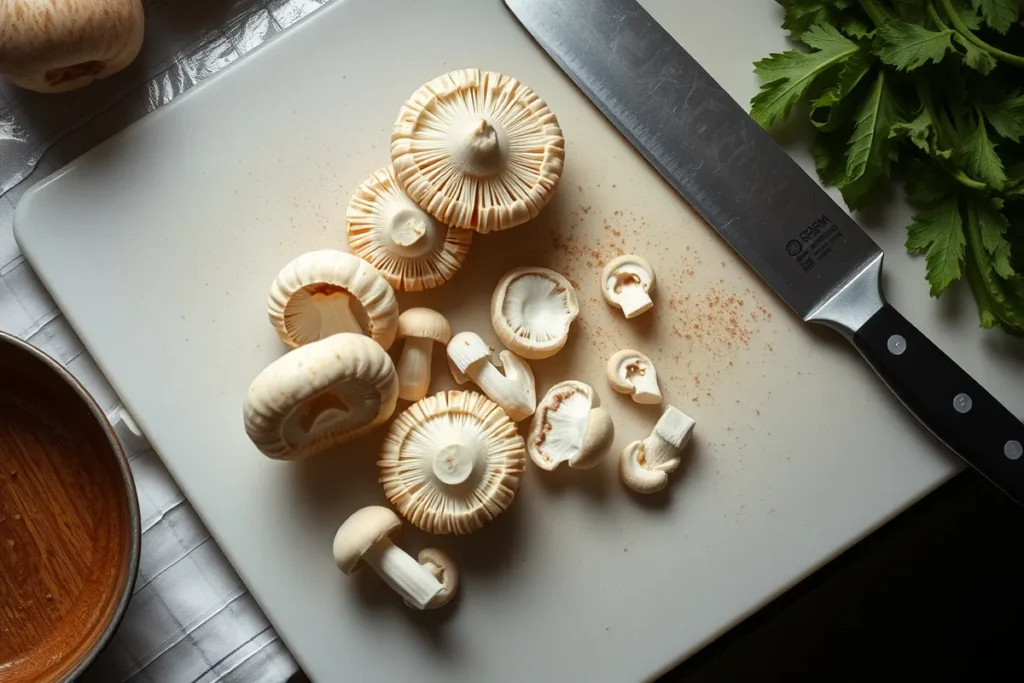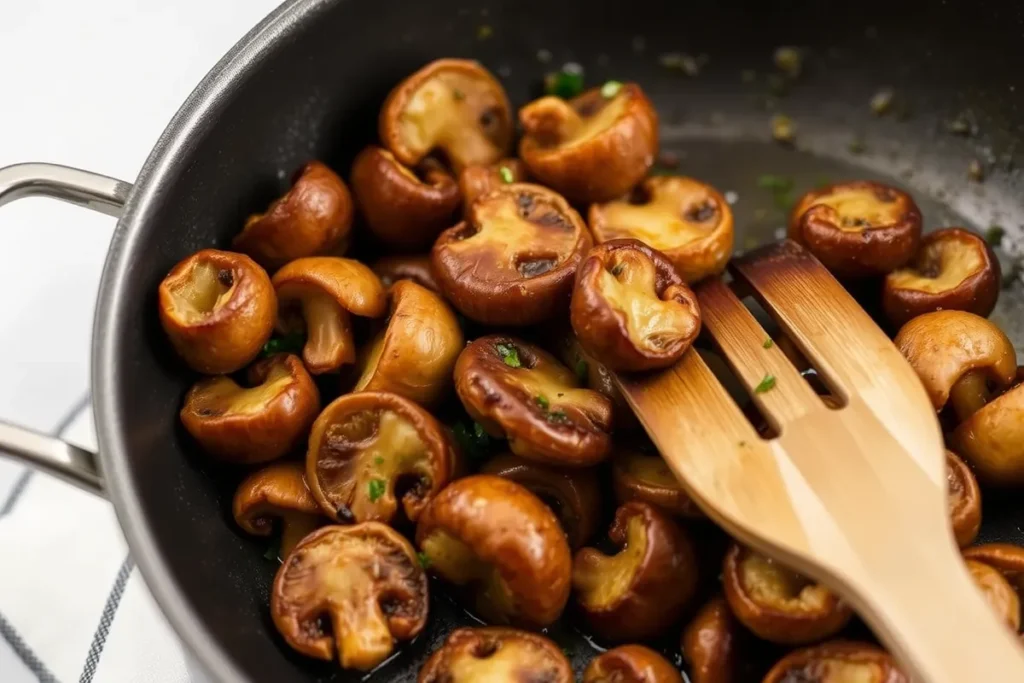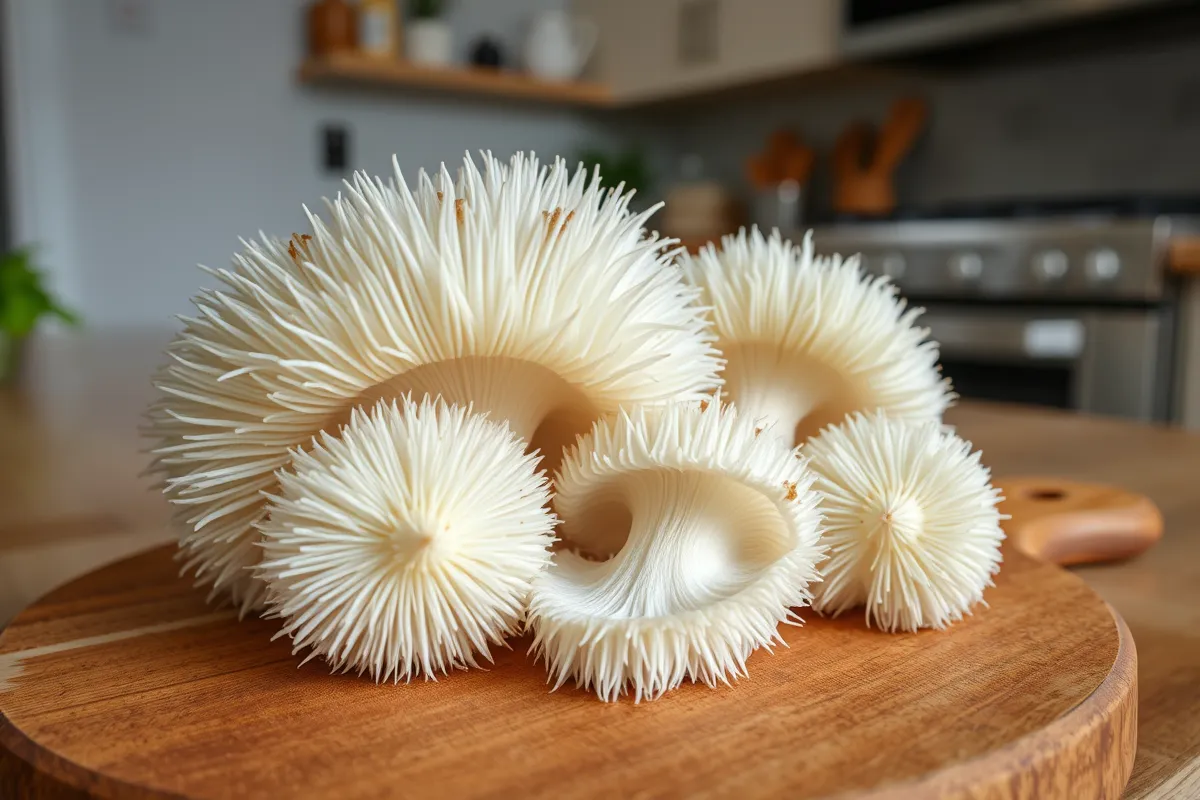Lion’s Mane mushrooms are more than just a culinary delight; they’re a powerhouse of nutrition and flavor, offering a unique experience for your taste buds and overall health. This article dives deep into exploring the best ways to eat Lion’s Mane mushrooms, guiding you through its preparation, cooking methods, and recipe ideas. Whether you’re a home chef or just someone curious about this fascinating fungus, you’re in for an exciting ride. Let’s begin with a closer look at Lion’s Mane mushrooms and their incredible benefits.

Introduction to Lion’s Mane Mushroom
What is Lion’s Mane Mushroom?
The Lion’s Mane mushroom, scientifically known as Hericium erinaceus, is a striking edible fungus with long, white, shaggy spines resembling a lion’s mane. Native to North America, Europe, and Asia, this mushroom is renowned not only for its visual appeal but also for its numerous culinary and medicinal uses. Often hailed as a superfood, it’s gaining popularity for its subtle seafood-like flavor and soft, meaty texture.
But it’s not just about looks or taste! What makes this mushroom truly stand out is its health benefits. Many traditional medicine systems have used Lion’s Mane mushrooms for centuries to enhance brain function, support the immune system, and even promote nerve repair. In fact, modern science is catching up, with studies highlighting its potential for boosting cognitive health and reducing inflammation.
Nutritional Profile and Health Benefits
Lion’s Mane mushrooms are packed with essential nutrients. A single serving offers a rich dose of antioxidants, dietary fiber, and protein. It’s also low in calories, making it a perfect addition to a balanced diet. Not to mention, it’s loaded with compounds like hericenones and erinacines that are believed to stimulate the growth of brain cells. How amazing is that?
These mushrooms also have anti-inflammatory properties, making them beneficial for managing chronic conditions. Research suggests they may help with memory, focus, and even stress reduction. For those looking to switch up their diet with functional foods, Lion’s Mane is a must-try addition.
Culinary Uses of Lion’s Mane Mushroom

Flavor and Texture Profile
Lion’s Mane mushrooms boast a flavor that’s often described as a cross between seafood and earthy mushrooms, with a slight hint of sweetness. When cooked, their meaty, tender texture can mimic that of crab or lobster, making them a favorite among vegetarians and seafood lovers alike. This versatile fungus can adapt to various cuisines, easily taking on the flavors of the spices and ingredients it’s paired with.
One bite into a well-prepared Lion’s Mane mushroom, and you’ll immediately notice its ability to absorb seasonings while maintaining a satisfying bite. This unique combination of taste and texture is what makes Lion’s Mane mushrooms a culinary treasure.
Popular Culinary Applications
Lion’s Mane mushrooms are incredibly versatile in the kitchen. They can be grilled, sautéed, roasted, or even turned into delicious mushroom-based “meats.” Whether you’re aiming for a simple side dish or a gourmet entrée, these mushrooms deliver every time. Here are a few popular ways to use them:
- Vegan Seafood Substitutes: Their texture is perfect for creating plant-based alternatives to crab cakes, scallops, or even fish fillets.
- Soups and Broths: Add them to soups for a chewy texture that soaks up broth flavors beautifully.
- Stir-Fries: Toss them with vegetables and sauces for a quick and healthy meal that’s bursting with flavor.
Additionally, they pair exceptionally well with garlic, thyme, and olive oil—ingredients that bring out their rich, umami notes.
Comparisons to Other Mushrooms
Unlike common varieties like button mushrooms or shiitakes, Lion’s Mane mushrooms stand out because of their shaggy appearance and distinct taste. While shiitake mushrooms offer a smoky flavor and portobellos are loved for their hearty texture, Lion’s Mane mushrooms bring a unique seafood-like flair to dishes. Plus, their health benefits and adaptability set them apart as a top choice for anyone looking to experiment with mushrooms in their cooking.
Preparing Lion’s Mane Mushroom for Consumption
Selecting Fresh Lion’s Mane Mushrooms
Before you can enjoy the best way to eat Lion’s Mane mushrooms, you must start with the right ingredients. Selecting fresh mushrooms is crucial. Look for mushrooms that are bright white, with no dark spots or discoloration. The shaggy spines should appear fluffy and intact, not matted or wilted. A fresh Lion’s Mane mushroom also has a mild, pleasant earthy aroma—avoid any with an off-putting or sour smell.
If you’re buying dried or frozen mushrooms, ensure they come from a reputable source to preserve their quality and nutritional benefits.
Cleaning and Storing Techniques
Cleaning Lion’s Mane mushrooms is easier than you might think, but it requires a delicate touch to maintain their texture. Here’s a quick guide:
- Dry Brush First: Use a soft brush or a damp paper towel to gently wipe off dirt. Avoid soaking them, as mushrooms absorb water and may become soggy.
- Trim the Base: The stem base can sometimes be tough or dirty; trimming it slightly ensures a clean and tender result.
For storage, keep fresh mushrooms in a paper bag in the refrigerator to maintain their quality for up to a week. Avoid airtight containers, as they can trap moisture and speed up spoilage.
Preparation Methods Before Cooking
To prepare Lion’s Mane mushrooms for cooking, slice them into thick pieces or shred them into smaller strands, depending on your recipe. These mushrooms often release water during cooking, so pre-sautéing them is a helpful step. This process not only reduces their moisture but also enhances their umami flavor.
For recipes like Lion’s Mane “crab cakes”, shredding the mushroom helps create a texture similar to crab meat. Meanwhile, slicing them thickly works well for grilling or roasting, as it allows them to hold their shape and develop a golden crust.
By mastering these preparation techniques, you set the stage for truly delicious meals. Whether you’re aiming for a simple sauté or an intricate dish, starting with clean, well-prepped mushrooms ensures success.
Cooking Methods for Lion’s Mane Mushroom

Sautéing
Sautéing is one of the most popular and straightforward methods for cooking Lion’s Mane mushrooms. It highlights their natural umami flavor while giving them a crispy exterior and tender interior. To sauté these mushrooms perfectly:
- Preheat the Pan: Use a non-stick or cast-iron skillet to ensure even heat distribution.
- Add Fat: Heat a tablespoon of olive oil, butter, or coconut oil. The fat enhances the mushroom’s flavor and helps achieve a golden-brown crust.
- Cook in Batches: Avoid overcrowding the pan; this allows the mushrooms to caramelize instead of steaming.
- Season Lightly: Sprinkle with salt, pepper, and your favorite herbs. Garlic and thyme are excellent companions for Lion’s Mane.
The result? Perfectly crispy, flavorful mushrooms ready to be a side dish or the main attraction in any meal.
Grilling
Grilling brings out the meaty texture of Lion’s Mane mushrooms, making them a satisfying addition to any barbecue or dinner spread. Their slightly smoky flavor complements their natural earthiness. To grill these mushrooms:
- Pre-Prepare: Slice the mushrooms into thick pieces to prevent them from falling through the grates.
- Marinate: A simple marinade of olive oil, lemon juice, garlic, and herbs can enhance their flavor. Let them soak for 20–30 minutes.
- Grill Over Medium Heat: Place the slices directly on the grill or use a grill basket. Cook for 4–5 minutes on each side until golden brown and tender.
Grilled Lion’s Mane mushrooms pair well with grilled vegetables or as a topping for burgers and sandwiches.
Roasting
Roasting Lion’s Mane mushrooms in the oven brings out their nutty, rich flavors while giving them a crisp outer layer. This method is perfect for those looking for a hands-off cooking approach. Here’s how to do it:
- Preheat the Oven: Set the temperature to 400°F (200°C) for even roasting.
- Prepare the Mushrooms: Toss the mushrooms with olive oil, salt, pepper, and optional spices like paprika or cayenne for added flavor.
- Spread Evenly: Arrange them in a single layer on a baking sheet lined with parchment paper.
- Roast: Bake for 15–20 minutes, flipping halfway through for an even texture.
Roasted Lion’s Mane mushrooms are perfect as a snack, salad topping, or even as a taco filling!
Incorporating Lion’s Mane into Recipes
Lion’s Mane “Crab” Cakes
One of the most popular ways to enjoy Lion’s Mane mushrooms is by transforming them into “crab” cakes. Their texture mimics crab meat, making them an excellent seafood alternative. Here’s a quick recipe outline:
- Prepare the Mushrooms: Shred cooked Lion’s Mane mushrooms into small strands.
- Mix Ingredients: Combine the mushrooms with breadcrumbs, mayo, Dijon mustard, parsley, Old Bay seasoning, and an egg as a binder.
- Shape and Cook: Form into patties and pan-fry in oil until golden brown on each side.
Serve these crispy cakes with a side of lemon wedges and tartar sauce. They’re not only delicious but also a healthier option compared to traditional crab cakes.
Lion’s Mane Stir-Fry
For a quick and nutritious meal, try a stir-fry with Lion’s Mane mushrooms. Their tender yet firm texture pairs beautifully with vibrant vegetables and a savory sauce. Here’s how:
- Prepare the Mushrooms: Slice the mushrooms into bite-sized pieces.
- Cook the Vegetables: Sauté onions, bell peppers, broccoli, and snap peas in a hot wok with sesame oil.
- Add the Mushrooms: Toss in the mushrooms, letting them absorb the flavors of the vegetables and sauce.
- Finish with Sauce: Drizzle a mixture of soy sauce, ginger, garlic, and honey over the stir-fry.
Serve it over steamed rice or noodles for a hearty, satisfying meal.
Lion’s Mane Soup
Turn Lion’s Mane mushrooms into a comforting bowl of soup that’s perfect for chilly days or when you’re craving something wholesome. This creamy, velvety soup is sure to become a favorite:
- Sauté the Mushrooms: Cook sliced Lion’s Mane mushrooms with onions and garlic until golden.
- Add Stock: Pour in vegetable or chicken stock, bringing it to a gentle simmer.
- Blend: Puree the mixture until smooth, adding heavy cream or a dairy-free alternative for creaminess.
- Season: Finish with salt, pepper, and a pinch of nutmeg for warmth.
This soup is not only rich in flavor but also packed with the health benefits of Lion’s Mane mushrooms.
Consuming Lion’s Mane in Supplement Form
Overview of Supplement Options
Not everyone has the time or opportunity to cook Lion’s Mane mushrooms. For these individuals, supplements provide a convenient way to enjoy their benefits. Available in various forms—powder, capsules, and extracts—Lion’s Mane supplements are crafted to preserve their potent bioactive compounds.
- Capsules: Ideal for people who prefer a precise daily dose with minimal effort.
- Powder: Perfect for adding to smoothies, coffee, or recipes without altering the dish’s flavor.
- Tinctures/Extracts: These are highly concentrated forms that can be taken directly or mixed into beverages for quick absorption.
Each type has its advantages, so selecting the one that aligns with your lifestyle is key. Always opt for high-quality supplements from reputable brands to ensure safety and efficacy.
Benefits and Considerations
Taking Lion’s Mane supplements offers a host of benefits similar to consuming them fresh, such as:
- Cognitive Support: Promotes memory, focus, and mental clarity, making it popular among professionals and students.
- Immune Boost: The mushrooms’ polysaccharides may enhance the immune system.
- Convenience: A quick, easy way to integrate the mushroom’s benefits into a busy schedule.
However, it’s important to consult a healthcare provider before starting any new supplement, especially if you’re pregnant, nursing, or taking medication.
Recommended Dosages
Dosage recommendations for Lion’s Mane supplements vary depending on the form and purpose:
- Capsules: Typically 500–1,000 mg daily.
- Powder: 1–3 teaspoons per day, mixed with food or drinks.
- Tinctures: Follow the manufacturer’s instructions, usually 1–2 droppers per day.
Consistency is crucial for reaping the full benefits of Lion’s Mane. Taking it regularly over weeks or months can help you notice improvements in cognitive function, mood, and overall well-being.

Frequently Asked Questions (FAQs)
Is it safe to eat Lion’s Mane raw?
Yes, you can eat Lion’s Mane mushrooms raw, but it’s not the most common way to enjoy them. When eaten raw, the texture can be spongy, and the flavor may not be as pronounced as when cooked. Cooking enhances their umami profile and makes them more palatable while preserving their nutritional value.
What does Lion’s Mane taste like?
Lion’s Mane mushrooms have a mild, seafood-like flavor, often compared to crab or lobster. Their meaty texture and delicate taste make them a versatile ingredient that pairs well with a variety of seasonings and dishes.
Where can I buy Lion’s Mane mushrooms?
You can find Lion’s Mane mushrooms at specialty grocery stores, farmers’ markets, or Asian markets. Alternatively, many online retailers and mushroom farms sell fresh, dried, or frozen Lion’s Mane mushrooms, making them accessible even if they’re not locally available.
How should I store Lion’s Mane mushrooms?
Fresh Lion’s Mane mushrooms are best stored in a paper bag in the refrigerator, where they can last for up to a week. Avoid plastic containers, as they can trap moisture and lead to spoilage. If you have dried mushrooms, store them in an airtight container in a cool, dark place.
Can Lion’s Mane be taken daily?
Absolutely! Many people take Lion’s Mane mushrooms or supplements daily to support brain health, reduce inflammation, and improve focus. However, moderation is essential. Follow recommended dosages on supplement packaging or consult with a healthcare professional for personalized advice.
Are there any side effects of consuming Lion’s Mane?
Lion’s Mane mushrooms are generally safe for most people. However, some individuals might experience mild digestive discomfort or allergic reactions, such as itchy skin or difficulty breathing. If you notice any adverse effects, discontinue use and consult a doctor immediately.
Conclusion
Summary of Best Practices
Lion’s Mane mushrooms are a culinary and nutritional treasure, offering an incredible mix of flavor, versatility, and health benefits. Whether you’re cooking them into “crab” cakes, stirring them into hearty soups, or simply sautéing them with olive oil and garlic, these mushrooms can transform any meal into something truly special. For those on-the-go, supplements provide an excellent way to integrate the benefits of Lion’s Mane mushrooms into daily life.
When preparing and cooking Lion’s Mane, focus on selecting fresh mushrooms, using proper cleaning methods, and experimenting with various cooking techniques to unlock their full potential. By doing so, you’ll enjoy their delicate seafood-like flavor and rich, meaty texture in ways that fit your dietary needs and preferences.
Encouragement to Explore Lion’s Mane in Diet
If you haven’t tried Lion’s Mane mushrooms yet, now’s the perfect time to explore this fantastic ingredient. Whether you’re motivated by their health benefits, culinary adaptability, or simply their unique flavor, these mushrooms are sure to impress. Dive into creative recipes, experiment with preparation methods, or add them to your wellness routine through supplements.
The best way to eat Lion’s Mane mushrooms is, ultimately, the way that brings you the most enjoyment. With so many options at your fingertips, the possibilities are endless. So, why wait? Make Lion’s Mane mushrooms a part of your next meal or daily wellness regimen and experience the wonders they have to offer!

